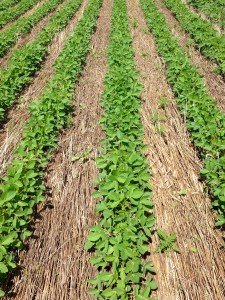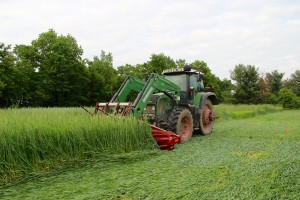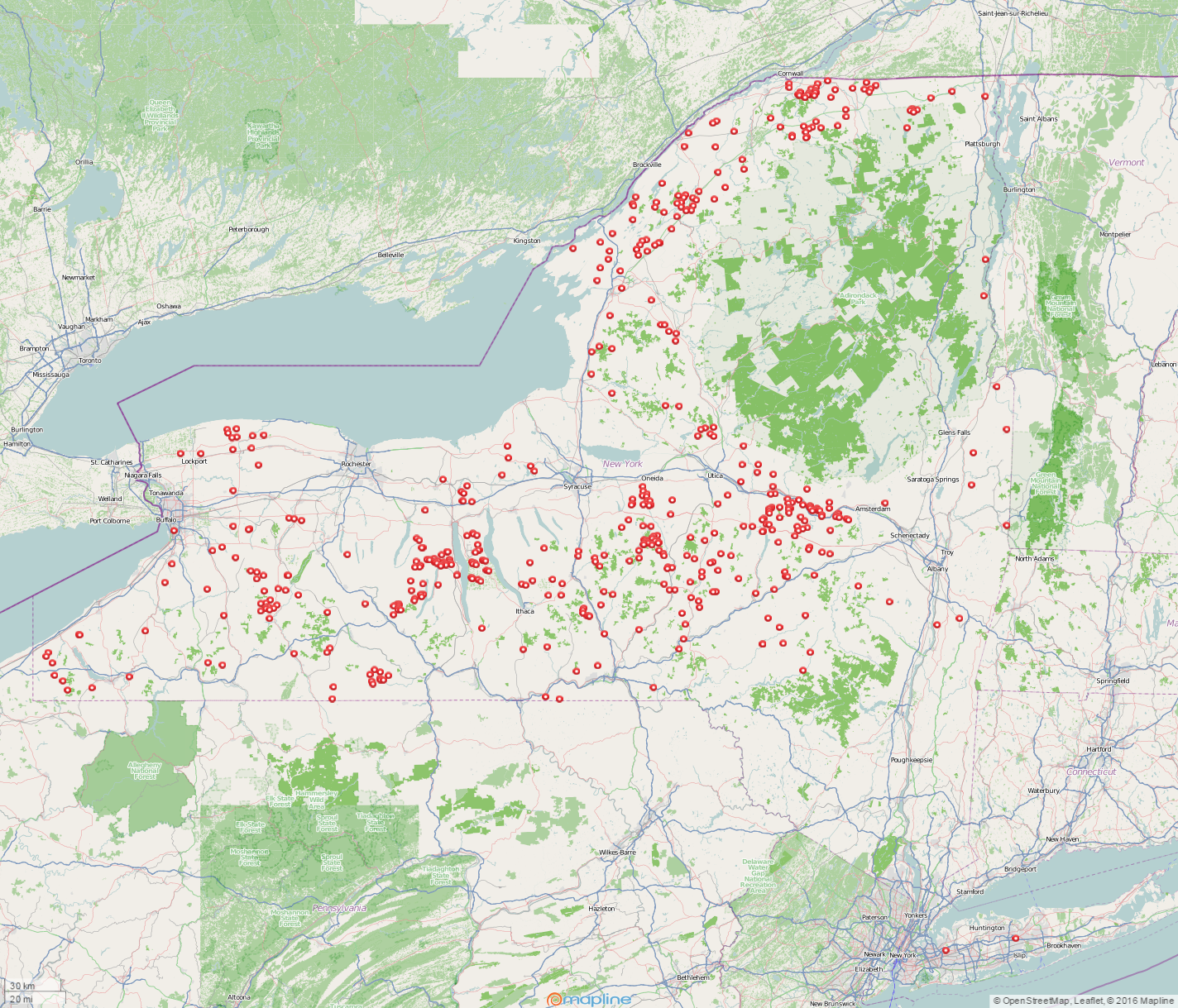June 2013 was a wet one, at least in Central NY. This fact was especially pertinent to Jeff Liebert, a graduate student in the Department of Soil and Crop Sciences at Cornell University. At the Musgrave Research Farm in Aurora, NY, topsoil was washed out from under an organic crop of tilled soybeans while its neighbor, another organic crop of soybeans, stood securely in place. The difference between these soybeans? A thick mat of cereal rye cover crop, bent at the base by a roller-crimper, kept the soil in place and the weeds at bay in the erosion-resistant no-till soybean plots.
(Soybean Crop at Musgrave Research Farm in Aurora, NY. Photo Credit: Jeff Liebert)
Traditionally, no-till has been limited to conventional crop production. Although reducing tillage can improve soil quality, this approach has largely been dependent on synthetic herbicides to control weeds. In organic systems, continuous no-till is generally impractical due to the proliferation of perennial weeds in the absence of synthetic herbicides. Fortunately, researchers at Cornell University are developing a cover crop-based, rotational no-till system as an alternative approach to weed management for organic farmers that are interested in reducing tillage.
Organic farmers growing corn-soybean-wheat in rotation can easily use over 20 tillage and cultivation operations over a 3-year period. For example, an organic soybean crop might require moldboard plowing, disking, and cultimulching to prepare the seedbed for planting, as well as 2-3 passes with an inter-row cultivator to control weeds while the crop is growing. In contrast, it is possible to produce the same three crops with less than 10 tillage events in a cover crop-based, organic, rotational no-till system by replacing the cultivation events with a rolled-crimped cover crop mulch for weed control. According to the USDA National Agricultural Statistics Service’s ‘2014 Machinery Custom Rates,’ farmers could save an average of $15.80 an acre by reducing cultivation through a no-till system. In addition to saving money by reducing labor and fuel, this cover crop-based, rotational no-till system can also protect and improve soil health.
In Geneva, NY, Liebert was a guest speaker at the NY Certified Organic meeting in March 2015. Focusing on the cover crop-based, organic, rotational no-till system, he highlighted important cover crop and soybean management practices to increase the likelihood of success for farmers who are new to this method of soybean production.
Cover Crop Management:
- Fitting organic no-till soybean into your crop rotation. This will likely mean thinking ahead about your crop rotation and fitting cover crop-based no-till soybean in when you can harvest the preceding crop in the summer or early fall. In the Northeast, winter wheat or short-season corn silage would work well as preceding crops since they are harvested in late summer, allowing you to sow a cereal rye cover crop in early- to mid-September.
- Sow cereal rye early in the fall. As mentioned, your crop rotation and the preceding crop (along with the weather) will determine when you can establish your cover crop. Although cereal rye can be established later than any other cover crop, sowing it early in the fall is strongly recommended. This will increase the weed suppression potential through greater biomass production and earlier ground cover.
- Choose a regionally adapted cereal rye variety. Although VNS or “bin-run” seed might be cheaper, it is important to use high quality, locally adapted seed to ensure good winter survival, productivity, and weed suppression. Find link to “Cover Crop Decision Tool”
- Drill the seed to improve stand uniformity. Drilling the cover crop into a clean seedbed in the fall will result in a much more uniform stand compared with broadcasting the seed, which tends to produce an uneven, patchy stand. As this cover crop will serve as your main form of weed control, uniformity is key. When a patchy stand is rolled, weeds are more likely to break through the cover crop mulch in areas where it was thin. A combination of drilling and broadcasting the seed can be effective, especially in long narrow fields when perpendicular planting is not convenient (see 7 below).
- Increase the seeding rate (and use narrower row spacing). Though it will not necessarily increase cereal rye biomass, a higher seeding rate of 3 bushels/acre should be used to increase ground cover, and thus weed suppression, earlier in the season. Similarly, using a drill with narrower row spacing will allow the cereal rye to cover the ground faster and gain an upper hand on weeds.
- Base termination on cover crop phenology. You will have the most success terminating the cover crop if you roll it at anthesis, when the plant is shedding pollen and anthers are visible. Cereal rye tends to bounce back up if it is rolled prior to this growth stage.
- Roll cover crops perpendicular to the direction they were drilled. This will maximize ground cover and create a more uniform mulch layer, increasing weed suppression. If this is not possible, the rolled cover crop stand will still provide adequate weed suppression if the other recommended management practices have been followed.
(Photo Credit: Jeff Liebert)
Soybean Management:
- Plant, rather than drill, your soybean seed. Planting your soybeans at 15- or 30-inch rows is generally recommended over drilling. It is more difficult to penetrate the mulch and pull many drill units through a field of rolled cover crop residue than it is to pull fewer, more widely-spaced planter units. Also, if additional weight is required (see next tip), it is more difficult to evenly apply enough down-pressure across many drill units compared with adding weight to a few planter units.
- Optimize seed-to-soil contact with planter adjustments and extra weight. Using a no-till planter with coulters, double-disk openers, and closing wheels, adjust the depth setting to ensure you are minimizing soil exposure and obtaining adequate seed placement at around 1.5 inches deep. If the soil is dry or your cover crop stand was particularly vigorous, you might need to add weight on the planter units to penetrate the mulch and achieve good seed-to-soil contact.
- Increase the seeding rate. That’s right, you just read this. A higher soybean seeding rate serves two main purposes: enhancing weed control and improving yields. A soybean crop will attain canopy closure more quickly when planted at a higher rate, which is useful for shading out late-season weeds and reducing the seed production of any early-season weeds that may have broken through the mulch. Also, since seed germination tends to be a bit lower in this cover crop-based system, a higher seeding rate will result in a higher final stand population and greater yields. The sweet spot is about 300,000 seeds/acre; much higher and soybean-to-soybean competition begins to decrease yield. Thus, a higher seeding rate can be considered a low-cost insurance for achieving high yields and enhanced weed suppression.
Research conducted by Cornell University agroecologist, Matt Ryan, in collaboration with USDA research ecologist, Steven Mirsky, compared seeding rates of 150,000 and 300,000 seeds/acre in Pennsylvania and Maryland. Despite higher seed costs upfront, Liebert’s economic analysis of these trials showed there was approximately a 30% ($240/acre) increase in partial profitability with the higher seeding rate due to increased yields and the high market value for organic soybeans. Preliminary results of Liebert’s own work in NY support these findings.
The cover crop-based, organic, rotational no-till system is applicable to other crops. However, it is very important to consider the compatibility between the no-till cash crop and the cover crop. For example, cereal rye depletes soil nitrogen (N). This characteristic gives soybeans a competitive advantage because it starves weeds of N, whereas soybeans are able to flourish by fixing their own N. In contrast, corn is a heavy feeder and therefore needs to be paired with a N-fixing cover crop, such as hairy vetch. No-till planting corn into cereal rye will result in severely stunted, N-deficient corn.
Find out more about organic no-till soybean and results from 2015 at the Cornell Sustainable Cropping Systems Lab website: https://scslabcu.wordpress.com/.




